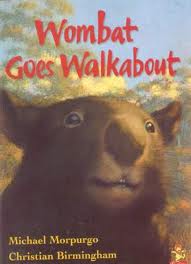 We traveled to the "land down under" where we met animals that aren't found anywhere else on earth. We met Joey the kangaroo, Twisker the bush mouse, Slider the snake, Prickler the echidna, Flatso the platypus, and Sly-tooth the crocodile in the book, Snap! by Marcia Vaughn.
We traveled to the "land down under" where we met animals that aren't found anywhere else on earth. We met Joey the kangaroo, Twisker the bush mouse, Slider the snake, Prickler the echidna, Flatso the platypus, and Sly-tooth the crocodile in the book, Snap! by Marcia Vaughn.
We met some more of their mates in There Were Ten in the Bed by Cheryl Orsini and Koala Lou by Mem Fox.
We played a game called, "I Spy Australia", where we had to pick a card and find the item on a big map of Australia. We had to look for things like, a kangaroo, a wombat, a koala, a kookaburra, a crocodile, a snake, a dingo, Australia's flag, a boomerang, a didgeridoo, an echidna, a tasmanian devil...
To the tune of "BINGO", we sang about a wild dog that lives in Australia- the dingo.
It goes like this:
Was a country had a dog and dingo was its name, oh!
D-I-N-G-O
D-I-N-G-O
D-I-N-G-O
And dingo was its name-oh!
Playing "Kangaroo Hopscotch", we jumped from 1 to 10 and back again.
 |
| Even Pooh Bear and Tigger got into the act! |
In honor of echidna, we played "Pick up Quills". It's just like the game "Pick up Sticks". We had to try to pick up a quill without moving the others. It was hard!
We sang the song "Kookaburra" over and over again:
Kookaburra sits in the old gum tree
Merry, merry king of the bush is he
Laugh, Kookaburra! Laugh, Kookaburra!
Gay your life must be.
Kookaburra sits in the old gum tree
Eating all the gum drops he can see
Stop, Kookaburra! Stop, Kookaburra!
Leave some there for me.
Kookaburra sits in the old gum tree
Counting all the monkeys he can see
Stop, Kookaburra! Stop, Kookaburra!
That's not a monkey, that's me!
Using toothpicks and gumdrops we made "Kookaburra Gumdrop Sculptures". We exercised such awesome self control by not eating them, we were each allowed to eat one when we were done- one that hadn't been handled:-) YUM! No wonder kookaburra eats them all up!
The didgeridoo is a rhythm instrument crafted by the aboriginal people of Australia. We used a didgeridoo, of sorts, to make some music of our own as we listened to didgeridoo music.
This artwork was illustrated in the book, Animal Dreaming by Paul Morin.
For those of us ready to practice our cutting and pasting skills, we cut Australian animals from a strip of paper and used a glue stick to place them on an outline map of Australia.
Over 3,500 years ago, Australian Aboriginies created unique handprints on cave walls by blowing a mixture of red ochre and water from their mouths over their hands. Artists also created unique rock paintings alongside their blown handprints to document their life. Traditional Aboriginal art uses lots of patterns and vibrant colors.
We made our handprints on a stone with vibrant colors to symbolize the traditional art of the Aborigines.
We read the book, Wombat Goes Walkabout by Michael Morpurgo.
We set off on a walkabout of our very own. It was "baking hot" just like in our story. We didn't see any animals from Australia but we practiced walking backwards, hopping like kangaroos and hopping backwards.





















































No comments:
Post a Comment